 Two weeks ago I had the privilege of being able to spend a few days out in Michigan with the design and marketing teams behind the Merrell Barefoot line of footwear. Merrell had invited me and Jay Dicharry, who is doing some testing for them in his lab at UVA, to discuss the state of the running shoe market, to summarize what we know about running form, and to do a bit of brainstorming about the future of their shoe line. As has been my personal policy to date, I accepted no consulting fee for the trip – I just enjoy working with people who are passionate about making innovative shoes. Merrell in particular is a company that I respect, and every person I have met from the company has been fantastic. They’re the real deal, and it was quite a lot of fun to hang out with them on the shores of Lake Michigan (honestly, a “business” meeting with an outdoor-sports company is quite unlike any other I have ever experienced – involved a lot of biking, running, and a few brave souls even did a bit of swimming!). On a side note, it was particularly interesting to be there just as Merrell’s parent company Wolverine Worldwide had acquired Saucony – it’ll be interesting to watch how the two companies interact going forward.
Two weeks ago I had the privilege of being able to spend a few days out in Michigan with the design and marketing teams behind the Merrell Barefoot line of footwear. Merrell had invited me and Jay Dicharry, who is doing some testing for them in his lab at UVA, to discuss the state of the running shoe market, to summarize what we know about running form, and to do a bit of brainstorming about the future of their shoe line. As has been my personal policy to date, I accepted no consulting fee for the trip – I just enjoy working with people who are passionate about making innovative shoes. Merrell in particular is a company that I respect, and every person I have met from the company has been fantastic. They’re the real deal, and it was quite a lot of fun to hang out with them on the shores of Lake Michigan (honestly, a “business” meeting with an outdoor-sports company is quite unlike any other I have ever experienced – involved a lot of biking, running, and a few brave souls even did a bit of swimming!). On a side note, it was particularly interesting to be there just as Merrell’s parent company Wolverine Worldwide had acquired Saucony – it’ll be interesting to watch how the two companies interact going forward.
One of the cool things about being at Merrell design headquarters for part of the trip is that I got to see a whole bunch of shoes that they have in the works. Shoe companies don’t typically allow discussion of products in development, so I haven’t said much about most of what I saw, but I got an email today from Merrell giving me the OK to post about their new M-Connect series of shoes, which they are announcing today. Here’s a snippet from the press release put out by Merrell about M-Connect:
“M-Connect Series includes four collections that are designed to enable ground connection but are built on different platforms based on activity – from Barefoot and Bare Access to Multi-Run with Mix Master and Multi-Hike with Proterra. All are built with agility in mind and range from zero to four-‐millimeter heel to toe drop and graded cushioning for enhanced ground response and necessary protection dependent on end-‐use and terrain.
Merrell Proterra is a brand new multi-hike collection that innovates with an agile approach to a traditional hiking product. The design combines Merrell’s heritage performance with Merrell Barefoot learnings for fast, breathable and durable hiking shoes and boots. Proterra is built on a four millimeter drop and demonstrated to improve a person’s stability through an outsole that enhances contact with the ground and a patent-‐pending upper that uses Stratafuse™ technology. Stratafuse injects the foot cage into the mesh upper, fusing it together for a lightweight fit, natural movement and incredible durability.
Additionally, Merrell Barefoot gets a major update with heightened ground feel and a new upper design for running and fitness. Bare Access also gets a design update with greater ground connection and upper design but maintains a minimally cushioned ride with eight millimeters of M Bound™ cushioning throughout. For multi-‐run activities, Mix Master sneakers are fast, flexible and light, and built on a four-‐millimeter drop for multi-‐tasking activities.”
Basically, Merrell is taking the barefoot concept and extending it a bit into the more transitional shoe category, and all of these shoes (barefoot styles included)will belong to the umbrella of M-Connect. They already have zero drop running shoes with minimal cushion (e.g., Road and Trail Gloves), and zero drop shoes with some cushion (Bare Access). They will be updating all of these styles, then adding in 4mm drop road and trail shoes (Mix Master), as well as 4mm drop light hikers and hiking boots (Mix Master Tuff, Proterra). New to the mix are several barefoot-style and zero-drop cushioned training shoes targeted for use in gyms, fitness classes, crossfit, etc (Flux, Hammer, Crush Gloves and Bare Access Shape). These moves make a lot of sense as different people will have different preferences as to just how far along the “barefoot” access they want to go, and this preference may also vary with the purpose the shoes are to be used for.
Below is a grid showing where all of the M-Connect shoes fit:
Having seen most of these shoes, I can tell you that they’ve done some fantastic work on the design end. I’m particularly excited about the Bare Access 2, which is updated with a super-minimal upper and a more flexible sole, and the Mix Master Move 4mm drop road shoe (my sweet spot for longer runs).
Merrell is really excited about the Proterra, which extends the minimalist concept to a hiking boot (Merrell’s roots are in the hiking boot business), and which has a unique sole design with inverted lugs – the light hiker in particular is an awesome looking shoe. The Mix Master Trail was released briefly earlier this year and was recalled, but will return soon with an updated upper that will solve a tearing issue that seemed to be occurring with the original version.
Various models in this collection will be coming up over the course of the next year, and I will hopefully have a few in the not too distant future to try out. Stay tuned!
In the meantime, here are some higher resolution images of the Merrell Barefoot Road Glove 2, Proterra Light Hiker, Bare Access 2 and Mix Master Trail:
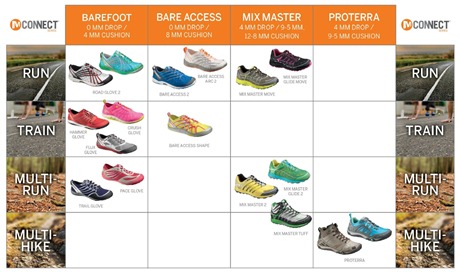
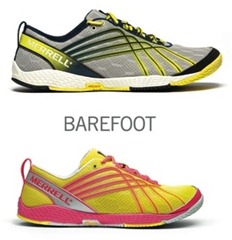
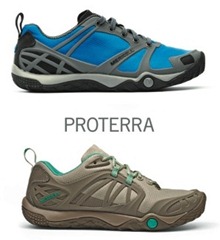
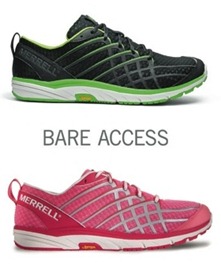
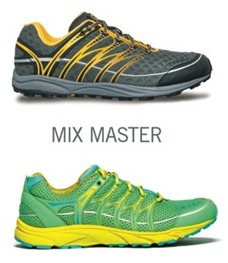

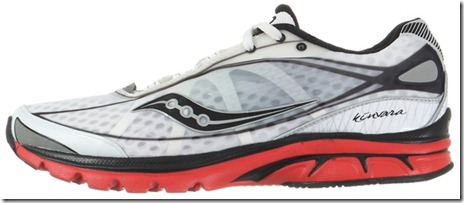

















Heel to toe drop and toe spring tells me they still don’t get it
Umm, heel toe drop in most of them is zero. And lack of toe spring can cause problems with forefoot material bending – look at the Vivobarefoot Evo.
Pete
—-
Pete Larson’s Web Links:
My book: Tread Lightly – Form Footwear and the Quest For Injury Free Running<http: 1616083743=”” gp=”” product=”” ref=”as_li_ss_tl?ie=UTF8&tag=thviofli-20&linkCode=as2&camp=1789&creative=390957&creativeASIN=1616083743″ http://www.amazon.com=“”> Work: link to anselm.edu…
Blog: https://runblogger.com
Dailymile Profile: link to dailymile.com…
Twitter: link to twitter.com</http:>
So why have drop at all is what I wonder. They can’t invent a shoe to overcome the forefoot bending? Next time you you see them challenge them to do so and ask them why not zero drop for all shoes. I’m sure they are nice folks and all but I wish we had more shoes companies that truly embraced barefoot biomechanics.
What do you mean exactly by “barefoot biomechanics”? While I like what Merrell is doing for the most part, I do agree that there are certain things are a bit bothersome like toe spring. That said, they are much more minimalist friendly than their competition.
As to why they don’t just zero drop all of their shoes, that’s just too easy. It simply won’t sell. Like it or not, it’s still a good idea to have traditional shoes, as that’s what most people have and buy.
For starters, looks at your foot the next time you are standing barefoot. Anything a shoe does to interfere with the way your foot operates whether in motion or at rest is simply wrong.
How many shoes actually retain their toe spring when you are standing in them? In my experience, they flatten out the moment your foot is inside. I can honestly say that I have never noticed toe spring when standing in a shoe. Furthermore, if you make a shoe with a completely flat sole and no spring it will make it harder to extend the toes upward prior to contact, which is also a typical feature of barefoot running mechanics.
Pete
—-
Pete Larson’s Web Links:
My book: Tread Lightly – Form Footwear and the Quest For Injury Free Running<http: 1616083743=”” gp=”” product=”” ref=”as_li_ss_tl?ie=UTF8&tag=thviofli-20&linkCode=as2&camp=1789&creative=390957&creativeASIN=1616083743″ http://www.amazon.com=“”> Work: link to anselm.edu…
Blog: https://runblogger.com
Dailymile Profile: link to dailymile.com…
Twitter: link to twitter.com</http:>
Since I’ve developed my feet from two years of barefoot running, the first thing I notice from shoes is the toe spring. I can feel the shoe pushing up on my toes. One way to combat this is buying an size or two larger so your toes don’t extend into the toe spring area. However, this creates more problems than it solves. If you like or don’t mind this artificial design element, you’re lucky I guess. I personally can’t stand it. Get it? I said stand. Ha!
i should add that my vivobarefootNeo’s toe spring flattened out after a week or so of wearing them everywhere
Maybe I’m the unluckiestguy in the world, but I’ve had plenty of shoes that retain the toe spring whilestanding in them. I guess my tyoes aren’t strong enough or something.
The biomechanics of walking and standing are not exactly analogous to the biomechanics of running. I run in the Road Glove and Bedrock Sandals exclusively, and I feel no difference between the two running, walking, and… standing. As I also do a lot of mountain running, I’m looking forward to trying the Mix Master. A bit of cushioning is nice when you are trying to run quickly on a rocky, technical trail. To each his or her own.
Get what? They have their zero drop minimalist shoes and now they want to introduce more traditional line of shoes. What’s wrong with that?
Here’s Jason Robillard’s take on toe spring – he helped with the design of the Merrell line and is about as experienced a barefoot runner as you will find: http://barefootrunninguniversi…
Pete
—-
Pete Larson’s Web Links:
My book: Tread Lightly – Form Footwear and the Quest For Injury Free Running<http: 1616083743=”” gp=”” product=”” ref=”as_li_ss_tl?ie=UTF8&tag=thviofli-20&linkCode=as2&camp=1789&creative=390957&creativeASIN=1616083743″ http://www.amazon.com=“”> Work: link to anselm.edu…
Blog: https://runblogger.com
Dailymile Profile: link to dailymile.com…
Twitter: link to twitter.com</http:>
Jason supports Merrell’s design decisions — no surprise. I just know that when I stand barefoot, my toes touch the ground and help with balance. I prefer footwear that respond to my naked foot — not the other way around. Back when I wore shoes, I loved the heavy Merrell shoes and all their engineering. They are coming around, but not fast enough for me. It is a difficult thing to admit all the shoes you’ve made in your past have inherently harmful attributes. Just look at Nike.
Toe spring in a minimal shoe is a most likely a work around for uppers that would otherwise fold into toes/foot at toe off. If you didn’t have uppers, or uppers properly designed with flex in mind then the toe spring would be far less important and could (and should) be removed completely.
Toe spring/rocker in a shoe with large/stiff soles is a work around for the lack of flex of the sole at the metatarsal heads.
Personally both I see both as a crude design trade-offs due problems introduced by other design elements of the shoes. Addressing these problems should be a priority rather than hacking the shoe design so that the problems move elsewhere.
As for toe spring not effect running mechanics, I call BS on this one. It may not effect where you land on your foot but it strongly effects your toes ability to apply force to the ground during stance. This in turn means it affects balance and pronation of the foot. Toe spring very much effects running mechanics.
Perhaps if one is very used to toe spring one might not ever engage ones toes properly during stance so one doesn’t notice the presence or absence of toe spring. However, if you do spend a lot of time barefoot or without footwear with toe spring and have naturally functioning toes then you’ll certainly feel that a toe spring is very artificial.
Of the shoes I have the ones which have the most flexible forefoot and the least amount of toe spring are the ones that I feel most comfortable, stable and natural in.
Pete,
Nice looking design direction with the new uppers. Do you know are they all on the Trail Glove last (merrell barefoot last?)? That is one of the few things keeping me from running more in Merrell is the last is just too narrow and too much taper at the big toe.
Pete,
Please please encourage Merrell to release some wide versions of these new shoes (preferably of the Mix Master from my point of view). The wide version of the Trail Glove is the first shoe I’ve found that fits my feet, but I need something with more protection for longer, rougher trail runs. Not even the Altra’s are wide enough, but the wide Trail Glove . . . aahhh. Heaven.
Cheers,
James
this looks good, i may get into the barefoot collection when it’s out…we’ll see, but i have my hopes up!
oh, and i hope merrell has a better foot shaped design! still disappointed about how the pinky toe is treated
Pete, do you know if there will be a reduction in arch support for the Road Glove? When I ran in the current model it felt like I had bags of sand under my outside arch. Very annoying!
I don’t know the answer, unfortunately all of the samples I saw were size 9 so I didn’t try them on.
Sent from my iPad
pete, i need a digital copy of “tread lightly”!!!
Working on it, hopefully it’ll come out this week!
—-
Pete Larson’s Web Links:
My book: Tread Lightly – link to ow.ly
Work: link to anselm.edu…
Blog: https://runblogger.com
Dailymile Profile: link to dailymile.com…
Twitter: link to twitter.com